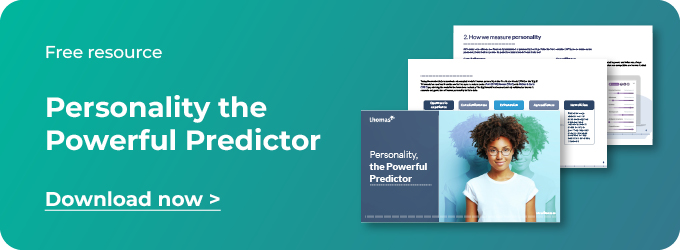When it comes to understanding personality traits, the acronym, OCEAN, is widely used to identify the five big traits that help define personality types. Openness, Conscientiousness, Extroversion, Agreeableness, and Neuroticism make up the big five and can provide employers and recruiters with useful insight into a candidate or colleague that will also help predict future career success or potential business disruption.
Understanding how conscientious a candidate or employee is in the workplace can give employers a clear advantage in developing workplace environments to suit business goals.
In this guide you will learn about conscientiousness as a personality trait, how those with a high level of conscientiousness behave in the workplace and why it is important to consider this in the hiring process. Finally, we will discuss how Thomas International can help you assess workplace personality, to hire better candidates for your business.
What is conscientiousness?
Conscientiousness is a trait that is commonly associated with awareness. Typically, conscientious people are well organized, demonstrate self-control and can plan their time very well. They are known as great team players and diligent workers.
There is a lot to be said about having a conscientious workforce or individual within a team. Often described as “the perfect personality for a team”, conscientious individuals demonstrate a strong work ethic, are reliable, punctual, pay attention to detail and show commitment and purpose. They are the characters that you will see plan their work to the last details or even time schedule.
When channelled correctly, a conscientious person can be a highly effective worker and this can impact the team and sometimes the organizational goals as well. Doing things “right” is the perceived measure of success for a conscientious individual.
“Right” can mean a number of things. From the personal perspective which includes morals, principles and habits but, it can also include traits such as processes, procedures and practices that are picked up over time. Doing it “right” can mean doing something that has been done over time elsewhere, forming an internal perception that it is as well, the only way to do it.
Doing it “right” can also be an external pressure that the conscientious worker experiences. This can be an organization’s policies, processes, procedures and practices. It can even include the company’s culture formed by norms, customs and precedents.

Traits of highly conscientious people
What are the typical traits of a highly conscientious person? Here are some of the most common traits associated with a conscientious individual.
Highly organized
It is very common to find a highly conscientious individual being organized. From their workspace to the work that they do. Having a structured approach to doing work and time management is high on the list.
Gets things done on time
Once a commitment is made to a time and deadline, conscientious individuals make it a point to stick to it. There is an almost internal compass that is morally driven to ensure that all work is completed on time and to schedule.
Self-disciplined
Being self disciplined is a very common trait of the conscientious worker. It has to do with being goal oriented and organized to the extent that you are relying on your own discipline to make it work.
Sticks to the rules
They are less likely to break company rules but also within their own lives they are more reliable to not break the rules. Studies have shown that a conscientious person is less likely to speed, over-eat and not smoke as much as those with less conscientiousness.
Detail-focused
It’s not just about the work they are doing, but how well based on what is being asked. Having a keen eye for detail is an essential trait of the conscientiousness characteristic.
Able to prioritize effectively
This comes down to organization and self-discipline. Distractions are a curse for a conscientious person. Knowing what they have to do and sticking to a deadline helps bring out the best in prioritizing the work that needs to be completed first.
Traits of people who have low conscientiousness
Of course, for every high level of conscientiousness that there is, there are those who have a low level of conscientiousness. This affects them in different ways and can have a business and team impact if not managed or understood correctly.
The traits of those who have a low level of conscientiousness include:
Disorganized
In comparison to a high level of conscientiousness, those with a lower level find it very difficult to get organized. From their time, to work management and even their desks can be untidy.
Dislikes structure
Having structure doesn’t allow low levels of conscientiousness to flourish. In fact, working outside of the rules, the common norms and values and even organizational rules suits these people.
Prone to procrastination
Without any kind of structure or awareness of time management, procrastination is a problem for those with low levels of conscientiousness. It is worth noting that supporting individuals with such low levels is necessary to get the work completed rather than get annoyed or frustrated with it.
Low motivation
Those with low levels of conscientiousness suffer with motivation. They are not dedicated to getting the job done or staying late. Being self-driven is not prevalent.

How to improve employees' conscientiousness
Luckily, conscientiousness is something that can be worked on by everybody. Fundamentally, this personality trait is another word for awareness. Building awareness that can actively benefit a workplace or organization is only a good thing.
There are several steps that an organization can take to developing conscientiousness within the business and through their employees.
Firstly, start by fostering a sense of priority to tasks in the business. Urgency and understanding that deadlines need to be respected will focus minds on how each individual needs to do their bit to make the goal of the business attainable. Help your team out by prioritizing work and getting everyone on board with doing that in their own tasks.
Secondly, help your team by remaining focused on work over external sources of information. It may be that you have to implement some internet blocking software or create a workplace environment that focuses teams to work together in tight deadlines to enable cultural change as well.
Fundamentally, conscientiousness or awareness takes place when individuals have more responsibility. It is common to find that conscientiousness increases the more someone gets promoted into a supervisor position as they know the urgency and importance of the work that is being carried out and how it has a wider impact on the business.
Finally, being able to speak with staff on a one to one basis to point out where they may need extra help or even gauge what is lacking is going to be of benefit. This can help overcome conscientiousness issues within teams and individuals alike.
Why conscientiousness is important in hiring decisions
When it comes to looking at your hiring decisions, one of the best traits that a candidate can have - in many but not all roles - is high levels of conscientiousness. Not only is it good for the business, but it also helps identify an individual’s suitability for a role and therefore it is a powerful hiring tool to understand who has a high or low level of awareness.
You want to be able to hire individuals who turn up to work on time, who will meet deadlines and who will give everything into all their work. Whether that be the CEO of a business or a cleaner, conscientiousness allows you to be more successful and helps the business achieve their goals quicker.
It has been shown over multiple studies that conscientious candidates for a role are resilient and good at overcoming obstacles. They are more likely to set achievable goals and work towards them - even when adversity strikes. But for employers there is also one key advantage to this personality type; they prevent bad things happening in the first place! This allows the business to focus on targets and goals and have safety in the knowledge that things are getting done.
When assessing conscientiousness this is giving practical insight into a candidate’s ability to work within teams and deal with customers - importantly, it is showing how well they can do this based on their level of high or low when compared to the other 5 big traits.
How Thomas assessments measure workplace personality
The Thomas workplace personality assessment can be used to understand a candidate or employees level of conscientiousness, and wider personality.
Using the globally recognized and respected big 5 psychological theory the High Potential Trait Indicator (HPTI) as it's also known, can also help to identify leadership potential.
The big five personality traits cover Openness, Conscientiousness, Extroversion, Agreeableness, and Neuroticism and present results in an easy to understand format that can give insight into a candidate’s suitability for a role.
Developed by Ian MacRae and Adrian Furnham in 2006, the HPTI has been designed based on an ‘optimality’ model, which assumes that personality traits can be considered ‘optimal’ based on the requirements of a particular job role or position, such as senior executive leadership.
Whether you are looking for the next superstar to join your team, possibly even start to change team dynamics or you want to measure the level of conscientiousness in your workplace, the HPTI assessment can analyze all the data in one place giving you insight in minutes.
In summary
Conscientiousness is a trait that is commonly associated with awareness. Typically, conscientious people are well organized, demonstrate self-control and can plan their time very well. They are known as great team players and diligent workers.
Those with a high level of conscientiousness are highly organized, self disciplined and detail orientated whilst those who have a low level of conscientiousness struggle with motivation and find it difficult to complete tasks.





